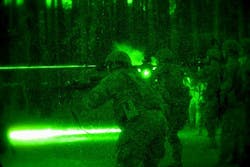Global demand for military electro-optics and infrared sensors to grow by 40 percent over six years
VANCOUVER, Wash., 14 Dec. 2016. Global demand for military electro-optics and infraredsensors should grow by 40 percent over the next six years, predict analysts at market research Markets and Markets in Vancouver, Wash.
The worldwide military electro-optics and infrared systems market should grow from $10.15 billion this year to $14.2 billion in 2022, which represents a combined annual growth rate (CAGR) of 5.75 percent, analysts say.
Markets and Markets experts outline their findings in a report entitled Military Electro-Optics/Infrared Systems Market, which segments the electro-optical and infrared market by platform, application, cooled and uncooled technology, staring or scanning technology, by hyperspectral and multispectral imaging technology, and by region.
Driving growth in the electro-optics and infrared market are two primary factors: increasing demand for battlespace awareness by defense forces; and technological advancements to improve efficiency, analysts say.
Also fueling the electro-optics and infrared market is growing demand for border surveillance and situational awareness using unmanned aerial vehicles (UAVs), analysts say.
Related: Quantum Imaging to provide infrared electro-optics for multispectral targeting systems
An increase in aerospace and defense research has contributed to the development of miniaturized and lightweight components and defense equipment, especially for airborne applications.
Based on sensor technology, the staring sensor segment should lead the military electro-optics and infrared systems market during the forecast period because these kinds of sensors gather more radiation and are able to handle complex moving parts of sensors and cameras on the battlefield, analysts say.
Staring sensors are used widely in missile warning receivers and electronic warfare systems. They are preferred over scanning sensors, as they are cost efficient and have varied technological applications.
The imaging system segment of the military electro-optics and infrared systems market should grow at the highest annual rate during the forecast period, due to developments in advanced laser and infrared technologies.
Related: Electro-optical sensor designers shrinking infrared pixel size to enhance resolution
Imaging technologies can provide high-resolution 3D images to locate and identify a target at much longer ranges than is possible with existing optical systems.
Several prototype optical surveillance and observation systems are expected to be developed that will demonstrate probabilities of recognition and identification at distances sufficient to allow standoff engagement and overcome atmospheric turbulence, which limit the ability of high-resolution optics.
North America should lead the military electro-optics and infrared systems market during the forecast period due to the increasing demand for electro-optics and infrared systems for military, public safety, and commercial applications there, such as laser rangefinders and infrared systems.
Major players in the military electro-optics and infrared systems market are Lockheed Martin Corp., Raytheon Co., and Northrop Grumman Corp. in the U.S.; BAE Systems Plc. in the United Kingdom; and Thales Group in France.
For more information contact Markets and Markets online at www.marketsandmarkets.com.
Learn more: search the Aerospace & Defense Buyer's Guide for companies, new products, press releases, and videos
